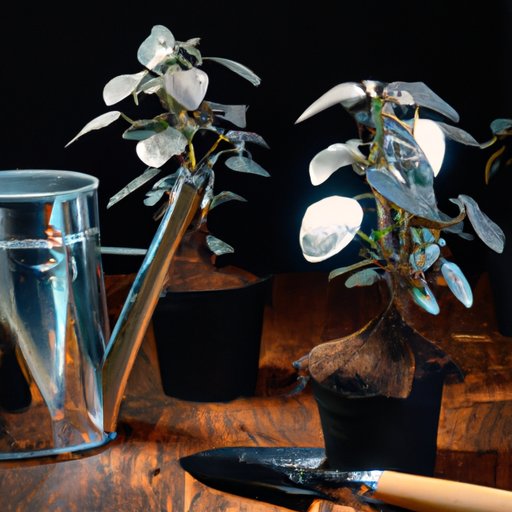Introduction
Aluminum plants, or Pilea cadierei, are popular houseplants that thrive in bright, indirect sunlight. They feature dark green leaves with silver markings and can reach up to 18 inches in height. While they’re relatively easy to care for, there are some important considerations to keep in mind when it comes to aluminum plant care. This article will provide an overview of aluminum plant care, including watering, fertilizing, pruning, potting soil selection, and maximizing light.
Benefits of Growing an Aluminum Plant
Aluminum plants are known for their hardiness and ability to tolerate lower light conditions. They can also help purify the air in your home by filtering out toxins like formaldehyde and benzene. As long as you provide adequate care, they’ll reward you with lush foliage and vibrant colors. Plus, they’re easy to propagate, so you can share these plants with friends and family.

How to Water and Fertilize Aluminum Plants
Watering is one of the most important aspects of aluminum plant care. The plant should be watered when the top inch of soil feels dry to the touch. Overwatering can be just as damaging as underwatering, so make sure to water only when needed. You should also avoid getting the leaves wet, as this can cause them to turn yellow or brown.
Fertilizing is also an important part of aluminum plant care. A balanced fertilizer (10-10-10) should be applied every two weeks during the growing season (spring and summer). During the winter months, you can reduce the frequency of fertilization to once a month. Be sure to dilute the fertilizer according to the package directions before applying it to the soil.
Tips for Pruning an Aluminum Plant
Pruning is another essential part of aluminum plant care. Trimming back the stems and leaves helps to encourage bushier growth and can also help prevent the plant from becoming leggy. Prune your aluminum plant in the spring or early summer to remove any dead or damaged leaves. Make sure to use sharp pruners and trim away any discolored leaves at the base of the stem.

Choosing the Right Potting Soil for Aluminum Plants
When selecting potting soil for your aluminum plant, look for a blend that is well-draining and rich in organic matter. Good potting soil should have a mix of perlite, vermiculite, compost, and peat moss. The soil should also provide adequate levels of nitrogen, phosphorus, and potassium for proper plant nutrition.
In addition to nutrient content, it’s also important to consider the drainage capabilities of the soil. If the soil retains too much water, the roots of the plant can become waterlogged and rot. Make sure to select a soil that drains quickly and doesn’t hold onto moisture for too long.

Common Problems with Aluminum Plants
While aluminum plants are generally hardy, there are a few common problems that can arise. Overwatering is one of the most common issues, as this can lead to root rot and fungal infections. If you notice the leaves turning yellow or brown, try cutting back on watering to see if this improves the situation.
Poor fertilization can also be an issue. If the soil lacks adequate nutrients, the leaves may start to turn yellow or brown. Make sure to feed your aluminum plant regularly with a balanced fertilizer to ensure it has all the nutrients it needs.
Finally, pests and diseases can also be a problem. Common pests include aphids, mealybugs, and scale insects. Diseases such as powdery mildew and botrytis blight can also affect aluminum plants. Treat any pests or diseases as soon as possible to prevent further damage.

Maximizing Light for an Aluminum Plant
Light is also an important factor in aluminum plant care. These plants prefer bright, indirect sunlight and should be kept away from direct sunlight, which can scorch the leaves. Artificial lighting can also be used to supplement natural sunlight. Fluorescent lights are ideal for providing additional light, as they emit less heat than traditional bulbs.
When positioning your aluminum plant for maximum light, make sure it’s not too close to the window. The sun’s rays can be very intense, so it’s best to keep the plant a few feet away from the window. You can also rotate the plant periodically to ensure all sides get an equal amount of light.
Conclusion
Caring for an aluminum plant requires a bit of knowledge and effort, but the rewards are worth it. With regular watering, fertilizing, pruning, potting soil selection, and maximizing light, you can create a thriving indoor garden. Keep in mind that aluminum plants are hardy and can tolerate lower light conditions, but they still need proper care to stay healthy and vibrant.
By following the tips outlined in this article, you can keep your aluminum plant happy and healthy for many years to come. Whether you’re a beginner or a seasoned gardener, aluminum plant care is an excellent way to enjoy the beauty of nature indoors.
Final Thoughts on Growing an Aluminum Plant
Growing an aluminum plant is a great way to add color and texture to your home. With proper care, it can thrive for many years, bringing life into even the dullest of spaces. Remember to provide ample light, water when needed, fertilize regularly, and prune as necessary. With the right care, your aluminum plant will reward you with lush foliage and vibrant colors.

